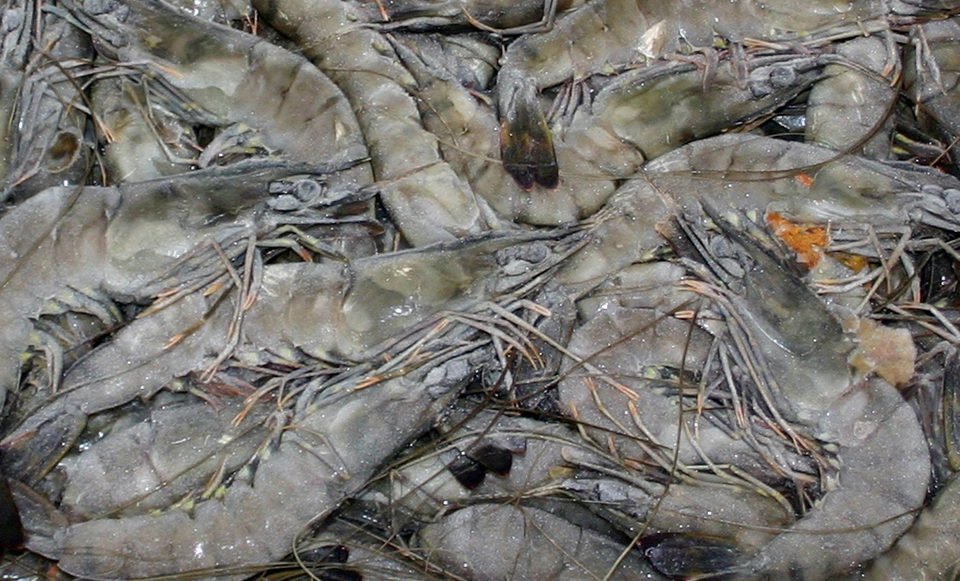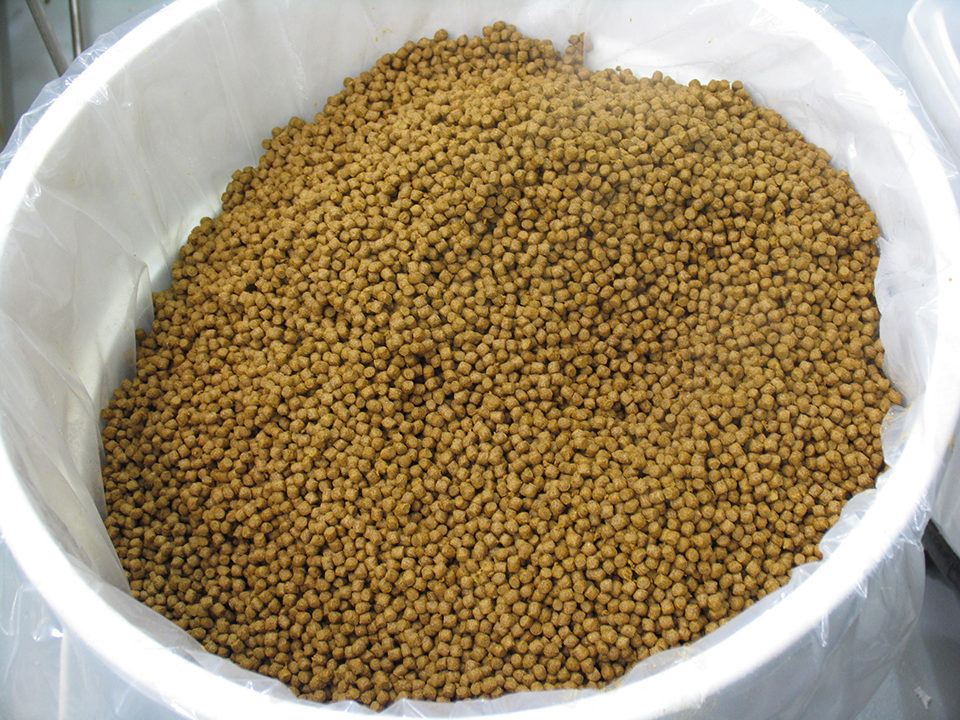Effects of feeds, processing, storage

A current trend in fish production is to increase the lipid content in diets to spare proteins, improve feed conversion and decrease the amount of waste produced by the fish. The fatty acid composition of fish muscle tissues reflects that of the diets given to the fish.
Diets containing higher amounts of n-6 fatty acids are responsible for an increased level of n-6 fatty acids in the fish muscles. Consequently, an increase in the relative amount of n-6-derived volatile aldehydes will be produced.
These compounds are generally thought to contribute negatively to the general aroma of fish muscle. Consistently, sensory results show a high value for the off-flavor effects of a high n-6 fatty acid diet.
Lipid-derived volatiles
Farming of carnivorous fish has traditionally required large quantities of fishmeal and oil. There is less and less availability of these materials, however, so the use of diets containing vegetable-based alternatives continues to increase.
Many odor-active compounds in the muscles of fish fed plant-based diets result from unsaturated fatty acid oxidation, particularly of aldehydes and alcohols. Aldehydes are probably the most interesting of the lipid-derived volatiles, since they have low odor thresholds.
The most easily perceived volatiles are two unsaturated alcohols (E)-2-penten-1-ol and (E)-2-hexen-1-ol. Both impart a strong mushroom-like odor. (E)-2-hexen-1-ol and (E)-2-hexanal exhibit a moss-like odor in fish. (E,Z)-2,6-nonadienal has a strong odor like cucumbers, which has been isolated in most seafood products. A grass-like odor observed in fish and crawfish has been related to (E)-2-pentenal.
Off-flavors from processing
Several aroma-active compounds in cooked rainbow trout, Oncorhynchus mykiss, have been identified as responsible for eliciting off-odors. The compounds were identified as (E)-2-nonenal, 2-ethyl-1-hexanol, 2,-methylnaphthalene and 8-heptadecene.
Odor defects in boiled cod, Gadus morhua, during storage were related to trimethylamine, butane-2,3-dione, methylpropanal, (Z)-3-hexenal, (Z,Z)-3-6-nonadienal, and 2- and 3-methylbutanal. In trout, Salmo fario, stored at minus-13 degrees-C, cetaldehyde; propionaldehyde; butane-2,3-dione; pentane-2,3-dione; and C6, C8 and C9 carbonyl compounds caused odors.

Off-flavors from storage
Some of these off-flavor compounds are produced by low-molecular-weight amine compounds that are normally present in the fish. During storage, they further degraded into ammonia or other nitrogenous compounds that impact flavor.
Other off-flavor compounds are produced from lipid oxidation during frozen storage. The compounds responsible for unacceptable flavor can be reduced through packaging that restricts oxygen transfer, incorporation of antioxidants, low frozen storage temperatures and reduced frozen storage time.
The volatile compounds produced during the spoilage of cold-smoked aquacultured fish have been traced to various bacteria. The Lactobacillus group released large amounts of volatile compounds such as acetic acid, ethyl acetate and n-propyl acetate. Also, dihydrogen sulfide was detected.
The other genus of lactic acid bacteria, Carnobacterium piscicola, produced 2,3-butanedione and 2,3-pentanedione, which produce a strong buttery odor. Because these volatiles are not particularly unpleasant, most consumers do not regard the product as spoiled. Brochothrix thermosphacta, which usually occurs in low numbers, produces higher amounts of 2-heptanone and 2-hexanone. These two compounds produced a spoilage odor similar to blue cheese.
Gram-negative bacteria produced high levels of volatile compounds such as trimethylamine, disulfide dimethyl, 2,3-butanediol and 2-pentanol. These compounds are often associated with amine, dirty sock or dishcloth odors. Shewanella putrefaciens produced trimethylamine, trimethylamineoxide and disulfide dimethyl.
Gutting has effects on the sensory properties of cod, hake and other gadoid fish. The gutting process noticeably increases the development of Gram-negative bacteria. In studies, counts of Enterobacteriaceae, Shewanella putrefaciens and Psewudomonas throughout ice storage were higher in gutted than ungutted samples. The differences in microbial loads were also reflected in lower sensory scores for both raw and cooked fish.
The off-flavors were due to the accumulation of trimethylamine, as well as elevated concentrations of putrescine, cadaverine, tryamine and histamine. The effects of these chemical changes showed that gutting may subject some fish to more rapid deterioration during ice storage, decreasing shelf life by four days.
The metabolic activity of several species of Carnobacterium was studied in cooked and peeled shrimp packaged in a modified atmosphere at 5 degrees-C. The bacteria contributed to the spoilage of the shrimp through the production of ammonia, tyramine, various alcohols, aldehydes and ketones. Two ketones – [5Z,8Z,11Z]- and [5E,8Z,11Z]-tetradecatriene-2-one – were recently reported as being responsible for the characteristic aroma of seafood products and also closely related to the flavor of cooked crustaceans.
Perspectives
The prevention of off-flavors in fish can be controlled to some degree through the implementation of good manufacturing practices. Using quality feeds and raising fish in high-quality waters free of chemical contaminants from biological, industrial or domestic sources are the first steps in the production of fish having high sensory acceptability.
Proper freezing procedures, as previously mentioned, retard many of the undesirable changes that occur during storage. Care of the product from harvest through consumption limits product degradation resulting from undesirable extrinsic changes due to bacterial decomposition and intrinsic, primarily enzymatic changes. It is impossible to eliminate many undesirable changes responsible for off-flavors, but they can be controlled so that consumers receive high-quality products.
Editor’s Note: Part I of this series discussed the effects on aquacultured products of off-flavors caused through the biological production of geosmin and 2-methylisoborneol. Part II addressed the effects of environmental and endogenous factors on unacceptable flavors in fish, crustaceans and mollusks.
(Editor’s Note: This article was originally published in the September/October 2011 print edition of the Global Aquaculture Advocate.)
Author
-

George J. Flick, Jr., Ph.D
Food Science and Technology Department
Virginia Tech/Virginia Sea Grant (0418)
Blacksburg, Virginia 24061 USA[117,100,101,46,116,118,64,103,107,99,105,108,102]
Tagged With
Related Posts

Intelligence
Off-flavors in aquaculture products, part 2
Off-flavors in seafood can stem from a variety of sources. Industrial effluents can at least secondarily contribute to off-flavors in fish. Off-flavor oxidative carbonyl compounds increase during cold storage of some farmed fish.

Intelligence
Off-flavors in aquaculture products, part 1
Off-flavors in pond and recirculating aquaculture systems have occurred through the biological production of geosmin and 2-methylisoborneol. The compounds are rapidly absorbed through the gills of fish, but depuration can require days or weeks.

Health & Welfare
Off-flavors in salmonids raised in RAS
The presence of compounds such as geosmin and 2-methylisoborneol (MIB) in recirculating aquaculture systems (RAS) can result in earthy or musty off-flavors in salmonids raised in the systems.

Health & Welfare
Biofloc technology reduces common off-flavors in channel catfish
In studies that used biofloc systems to culture channel catfish, culture tanks were susceptible to episodes of geosmin and 2-methylisoborneol and subsequent bioaccumulation of off-flavors in catfish flesh.

